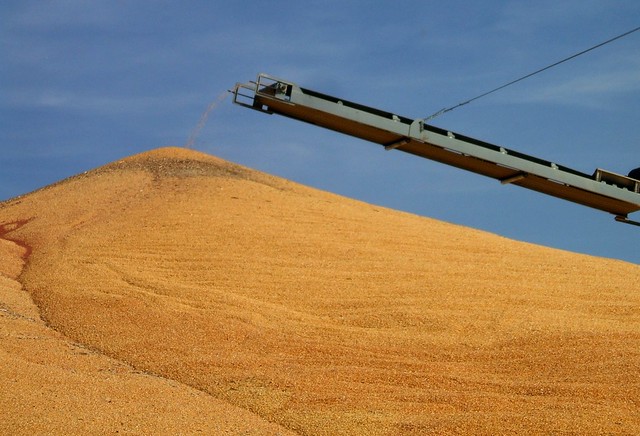
1,500,000 bushels of corn 2 miles East of Kearney, Nebraska (2010)
photo: flickr cc via ConanTheLibrarian
The writing to follow is by Daryll E. Ray and Harwood D. Schaffer, Agricultural Policy Analysis Center, University of Tennessee, Knoxville, Tennessee. It addresses today's seldom spoken-of topic of agricultural commodity overproduction, citing history and quoting Jason Henderson. This certainly goes against conventional views which repeat ad nauseam that there will be ever-increasing demand for U.S. agricultural commodities by the BRICS and other nations.
Note that back in May, I covered Henderson's warnings on this same subject of the BRIC nations increasing their agricultural production in this post — if you want to learn more — using a report (with graphs) from the Federal Reserve Bank of Kansas City. Henderson is an economist for the FRBKC at its Omaha branch.
——Kay McDonald
Farmers have consistently produced themselves out of prosperity—what about this time?
In reading Jerry Hagstrom’s report on a 3-day conference, Agriculture Investment Summit for the Americas, we were struck by the witty insight of Jason Henderson when he said,
In that one sentence, Henderson, executive vice president of the Omaha branch of the Federal Reserve Bank of Kansas City, summed up what agricultural economists have long known. Historically, the production of agricultural crops, sooner or later, outruns demand, resulting in multi-year periods of low prices. The same is true in the shorter-run for livestock, although producers there adjust production much more quickly than crop producers resulting what have historically been hog and cattle cycles.
This tendency towards over-production is not a new phenomenon in US agriculture. Shortly after the settlement of the first colonists in North America, farmers began to ship a new-fangled product called tobacco to London. Smoking caught on like wildfire—so to speak—and the production of tobacco became very lucrative.
The price was so lucrative that others quickly began to produce so much tobacco that within 40 years they had flooded the market. Prices fell so dramatically that several colonies were looking at acreage restrictions on the planting of tobacco in order to boost prices to a profitable level.
For a time, the production of indigo in the US South was profitable, but with increased production in the US, Central America, and South America, along with the advent of the Revolutionary War and the loss of the British per pound bonus, US producers could no longer compete and the domestic market collapsed, never to recover.
The pattern of profitable prices, followed by increased production and the addition of new production areas, resulting in long troughs of low prices has plagued the producers of corn, cotton, and wheat through much of US history, particularly following the Civil War and opening up of the Great Plains to crop agriculture. In the last century, this pattern was repeated following WWI, WWII, and the export boom of the 1970s.
We are now experiencing a similar boom and at the investing summit, Gerald Bange, Chair of USDA’s World Agricultural Outlook Board, told his audience “We’re not going to see $2 and $3 corn again in the” US. Much of his optimism is based on ethanol production and a growing export demand.
To date, agricultural exports to China, India, and Russia have been growing resulting in an ethanol/export led prosperity for US farmers. As Hagstrom reports, Henderson cautioned his audience that “growing world markets may not always be there.”
Henderson based his caution on a look at the stages countries go through in the development process. In Stage One, a country begins to increase the importation of food just as Brazil did in the 1970s and Russia did with meat products in the 1990s.
Russia, along with China, is in Stage Two where they are seeking to “expand protein production with an eye toward feeding themselves and shrinking meat imports.” To do this they have increased their imports of soybean meal.
Brazil is now in Stage Three, a stage where they increase their production of crops so they no longer have to purchase imports to feed their own animals.
In Stage Four, a country begins to compete with their former suppliers, exporting both crops and protein. Brazil is there with regard to soybeans and is likely to soon be there when it comes to corn, wheat, beef, pork, and poultry.
If the pattern holds, Russia and China may not be too far behind.
Daryll E. Ray holds the Blasingame Chair of Excellence in Agricultural Policy, Institute of Agriculture, University of Tennessee, and is the Director of UT’s Agricultural Policy Analysis Center (APAC). Harwood D. Schaffer is a Research Assistant Professor at APAC.